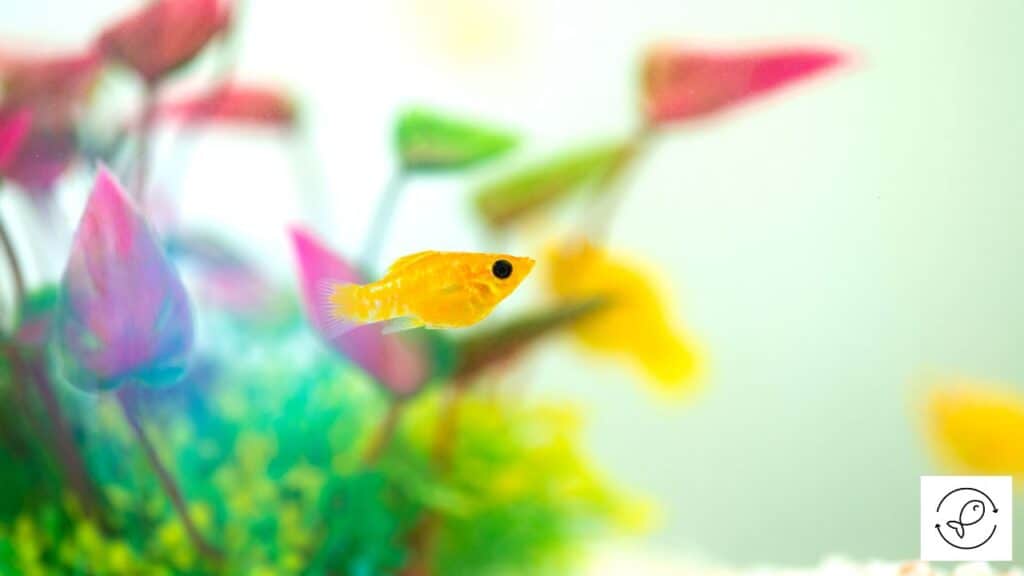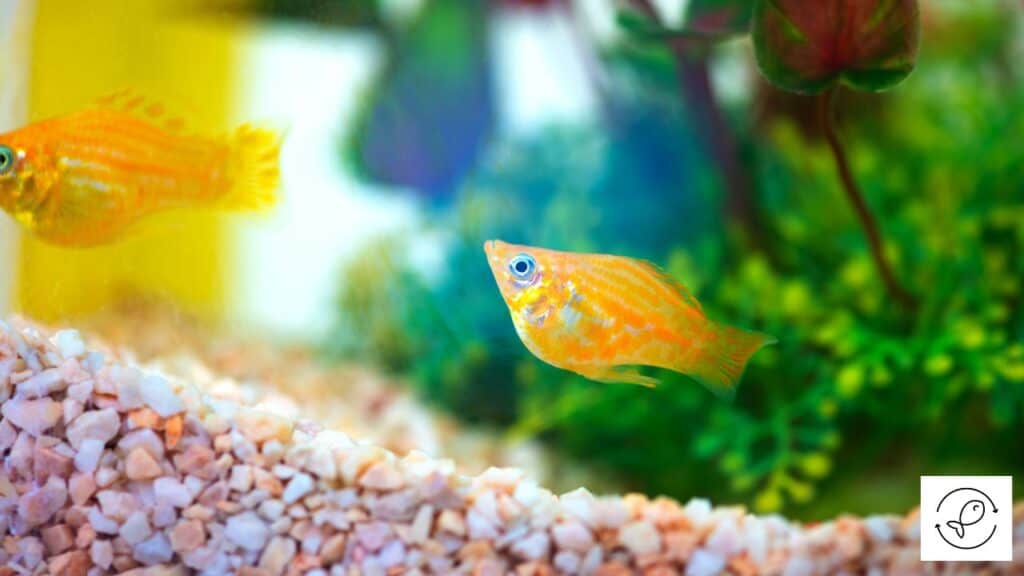Mollies can live with bettas since they share similar water parameters and diets. Providing ample hiding places, maintaining ideal water parameters for both species, a large tank, and a nutritious diet is vital for their co-existence. However, bettas’ aggressive behavior causes problems for mollies.
Let’s learn more about the challenges of housing mollies and bettas together and ways to help them co-exist peacefully.
How to Keep Mollies and Bettas Together?
Mollies and bettas display different behaviors.
Hence, many aquarists think twice before housing these two species together.
However, with proper planning and preparation, it’s possible to keep mollies and bettas together in a peaceful environment.
Given below are some tips to help you keep mollies and bettas together:
Invest in a large tank.
Bettas and mollies need an appropriately-sized tank to co-exist.
The larger the tank, the more space there is for both the fish species to swim around and explore.
Mollies thrive in a group of 4 or more. So the tank must be large enough to accommodate both fish species.
Bettas are territorial. They don’t like other fish invading their territory.
Hence, a large tank will prevent mollies from entering the bettas’ territory. This will lower the likelihood of conflicts.
A minimum 20-gallon tank is recommended for keeping mollies and bettas together, but a 30-gallon or larger tank is even better.
A big tank helps in keeping the water parameters stable.
It also allows essential equipment like a filter, heater, and other decorations to be placed inside without creating any space constraints for the tank inhabitants.
Maintain ideal water parameters for both species.
Maintaining ideal water parameters is essential for both mollies and bettas.
Mollies need water temperatures between 72°F and 82°F. Bettas thrive at a temperature of 78°F.
So you can set the temperature to 78°F for both species.
Mollies prefer slightly alkaline water with a pH of 7.5 to 8.5, while bettas prefer slightly acidic water with a pH of 6.5 to 7.5.
However, you can adjust the pH to be around 7.5 for both species.
You can use a water testing kit to check the water parameters regularly and adjust them accordingly for both species to thrive.
Provide ample hiding places.
Mollies and bettas need hiding places to feel secure.
You can add live plants, driftwood, rocks, caves, and other decorations to the tank.
This will provide plenty of hiding places for both species.
Mollies and bettas can also rest in these places when they are stressed or sick.
Hiding places can also help reduce the stress on bettas and mollies. The fish can feel comfortable and secure in their own space.
Hiding places also help recreate the natural habitat of mollies and bettas.
Feed a well-balanced diet.
Mollies and bettas both need a balanced diet to stay healthy.
The good thing is that mollies and bettas share similar dietary requirements.
Bettas, being carnivores, primarily need a protein-rich diet for optimal growth.
On the other hand, mollies are omnivores. They need both plant and animal matter to stay healthy.
Hence, you can feed mollies and bettas various food such as flakes, pellets, veggies, and live or frozen food items.
Include some vegetable fiber in your bettas’ diet to improve their digestion.
Besides, live or frozen food, such as bloodworms, brine shrimp, daphnia, etc., can be good sources of protein for mollies.
A diverse and balanced diet will ensure that both fish get the essential nutrients for their optimum growth.
Maintain the tank regularly.
Mollies and bettas need clean water to thrive. Poor water quality can stress both fish species.
It can trigger aggression between them and cause other health issues.
Hence, it’s vital to check the water parameters regularly and perform partial water changes every week or two.
Also, make sure to remove any uneaten food or waste from the tank since it can lead to ammonia build-up.
This can be toxic for both fish species.
Regularly cleaning the substrate, filter, heater, and other decorations is essential for their proper functioning.
This will help maintain a healthy environment for both mollies and bettas.
House a group of mollies with bettas.
Mollies are shoaling fish. They need to be in small groups for their own safety and well-being.
Hence, it’s important to house a group of mollies with bettas.
It’s best to keep the male-to-female ratio in mind while housing a group of mollies.
A ratio of one male molly for every three female mollies is ideal.
This will help to curb the aggression of male mollies toward female mollies.
You can keep a single male betta fish with mollies.
If you want to have a group of bettas, female bettas are the best choice since they are less aggressive and can live together.
Also, a sorority of female bettas can happily co-exist with mollies.
Challenges in Keeping Mollies and Bettas Together

Mollies are considered good tankmates for bettas due to their docile nature and hardiness.
However, there are certain challenges while housing mollies and bettas in the same tank.
Given below are the main difficulties that you may face while keeping mollies and bettas together.
Fighting Among Mollies and Bettas
Bettas and mollies have different temperaments. Bettas are more aggressive and territorial, while mollies are peaceful and social.
However, male mollies are territorial toward each other.
So if you keep 2 or more male mollies, their fighting can stress the bettas.
On the other hand, bettas can get aggressive if their territory is invaded or the living conditions become stressful.
Hence, it’s vital to keep an eye on both species to ensure that they don’t fight or bully each other.
Bettas Nipping the Fins of Mollies
Bettas get territorial when they feel threatened. They may nip mollies’ fins if they sense any danger.
Male mollies are vibrant in color with long and flowing fins. This can attract a bettas’ attention.
Bettas can often try to nip the long and bright-colored fins of mollies.
Hence, you must choose the molly species carefully while housing them with bettas.
Short-finned and Dalmatian mollies come without long and trailing fins. So they are a better choice for housing with bettas.
Aggression During Feeding
Bettas can sometimes become aggressive during feeding, especially if they are starving.
They can try to steal food from mollies and can even nip them in the process.
Hence, it’s vital that you feed both species adequately.
You can spread the food in the tank to ensure that both of them get enough food.
Another way is to catch the betta in a net and drop the food in it.
This will ensure that both bettas and mollies get their share of food.
Mollies Reproducing Alarmingly
Mollies are popular for their reproducing ability.
They can reproduce every month from a single mating due to their capability to store sperm for longer periods.
So if you keep male and female mollies in a tank, their chances of mating increase.
Hence, the tank can get overpopulated with molly fry.
Besides, bettas can eat molly fry easily. This can be a problem, especially if you want to raise the fry.
Mollies Growing Larger than Bettas
Bettas are smaller compared to mollies. They can grow up to 2.5 inches in length.
On the other hand, the average size of mollies is around 4.5 inches.
Some molly species, like Sailfin mollies, can even grow up to 6 inches.
Their large size can stress the bettas and make them feel vulnerable.
To counter this, you can choose smaller-sized molly species like the common black molly.
Are Mollies Suitable Tankmates for Female Bettas?
Mollies and female bettas are good tankmates. You can even house a female betta sorority with mollies.
Female bettas are less aggressive compared to male bettas.
However, they usually get aggressive while establishing a pecking order among themselves.
Once the order is established, they calm down and can co-exist peacefully with mollies.
So you need to invest in a large tank while keeping mollies with female bettas.
This will help to curb the aggression as both species will have ample space to claim their territories.
Besides, mollies won’t get caught up in female betta fights while they are establishing a pecking order among themselves.
Can Betta Fish Hurt Mollies?
Bettas are known for their fighting capabilities. They usually attack other fish when conditions aren’t suitable.
Hence, bettas can attack mollies if they are starving or stressed due to unsuitable water conditions.
So it’s essential to maintain the ideal water parameters and feed them a well-balanced diet.
Although bettas can fight with mollies, cases of bettas fatally injuring the mollies are rare.
However, you need to ensure that the tank is large enough to provide ample space for both species.
This will help reduce the aggression and keep them away from each other.

